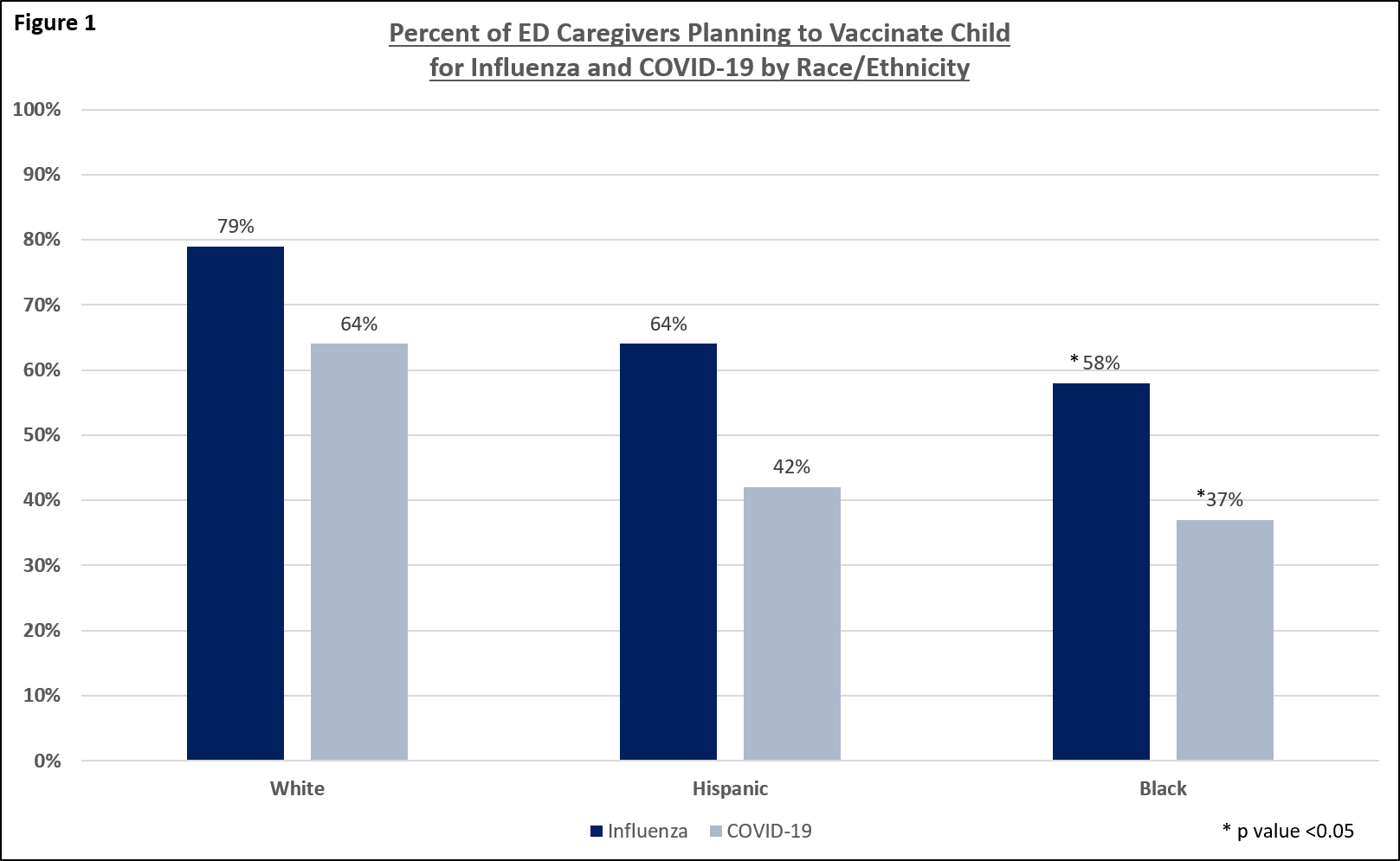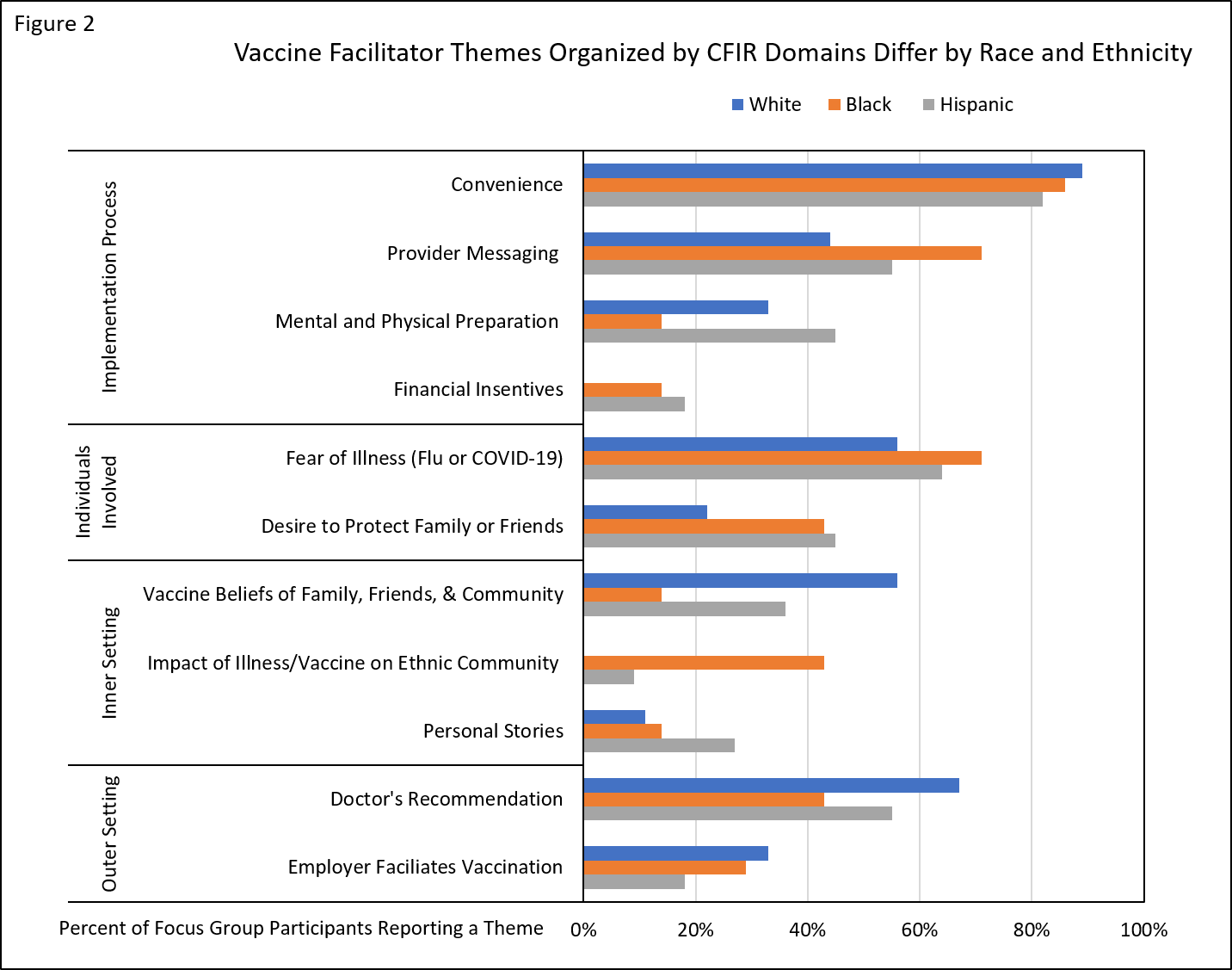Immunizations/Delivery
Category: Abstract Submission
Immunizations/Delivery I
510 - Understanding Vaccine Hesitancy, a Method to Improve COVID-19 and Influenza Vaccine Acceptance in Racial and Ethnic Minorities
Sunday, April 24, 2022
3:30 PM - 6:00 PM US MT
Poster Number: 510
Publication Number: 510.325
Publication Number: 510.325
Shannon H. Baumer-Mouradian, Medical College of Wisconsin, Wauwatosa, WI, United States; Rebecca J. Hart, University of Louisville/Norton Children's Medical Group, Louisville, KY, United States; Swathi Prasad, Medical College of Wisconsin, Wauwatosa, WI, United States; David Brousseau, Medical College of Wisconsin, Milwaukee, WI, United States

Shannon Baumer-Mouradian, MD
Associate Professor, Pediatric Emergency Medicine
Medical College of Wisconsin
wauwatosa, Wisconsin, United States
Presenting Author(s)
Background: Influenza and COVID-19 place a higher burden of disease on Black and Hispanic children compared to Whites, yet, influenza vaccination rates are lowest in Black children, with similar trends expected for COVID-19 vaccines. Qualitative studies are needed to better understand vaccine hesitancy in racial and ethnic minority caregivers.
Objective: 1) Compare influenza and COVID-19 vaccine hesitancy levels in Black, Hispanic, and White caregivers. 2) Identify vaccine facilitators and barriers unique to racial and ethnic minority caregivers.
Design/Methods: We performed a prospective survey and six follow-up focus groups on caregivers with children 6mo-18yo presenting to the pediatric ED. Vaccine hesitancy was measured using a previously validated tool. We compared vaccine acceptance among race/ethnicity groups using chi squared test. Focus groups were stratified by caregiver race/ethnicity and intent of caregivers to receive COVID-19 vaccine for themselves. We coded focus group responses and identified subthemes using the Consolidated Framework for Implementation Research (CFIR). Frequency of facilitator and barrier themes was measured as a proportion of total number of participants mentioning that theme.
Results: Of 586 caregiver surveys, 68% (n=398) planned to vaccinate their child for influenza (2021-2022) and 50% (n=296) for COVID-19. Influenza and COVID-19 vaccine acceptance rates were lower in Black and Hispanic caregivers compared to Whites (Figure 1). Focus group data from 23 caregivers demonstrated the most common facilitator themes (reported in at least 30% of participants) included: convenience, provider messaging, fear of illness, and doctor’s recommendation. Most common barrier themes included: side effects, inadequate data to support vaccines, lack of necessity, and distrust of the medical system/science/government. Facilitators and barriers differed by race and ethnicity. White and Hispanics more frequently mentioned mental and physical preparation and vaccine beliefs of others as facilitators, and Blacks more frequently mentioned provider messaging and impact on the community (Figure 2). Regarding barriers, Hispanics and Blacks reported all themes more commonly than Whites, with Blacks noting distrust and vaccine mandates (Figure 3).Conclusion(s): Black and Hispanic caregivers report higher vaccine hesitancy toward influenza and COVID-19 vaccines for children compared to Whites. We identify unique racial and ethnic differences in facilitators and barriers of vaccination and propose interventions designed to equitably improve the uptake of pediatric influenza and COVID-19 vaccines.
Percent of ED Caregivers Planning to Vaccinate Child for Influenza and COVID-19 by Race/Ethnicity Black caregivers were less likely to vaccinate their child for Influenza and COVID-19 compared to White caregivers.
Black caregivers were less likely to vaccinate their child for Influenza and COVID-19 compared to White caregivers.
Vaccine Facilitator Themes Organized by CFIR Domains Differ by Race and Ethnicity White and Hispanic caregivers more frequently reported mental and physical preparation, vaccine beliefs of family/friends, and doctor's recommendation as facilitators. Where as Black caregivers more frequently reported provider messaging and impact of illness/vaccine on ethnic community as facilitators.
White and Hispanic caregivers more frequently reported mental and physical preparation, vaccine beliefs of family/friends, and doctor's recommendation as facilitators. Where as Black caregivers more frequently reported provider messaging and impact of illness/vaccine on ethnic community as facilitators.
Objective: 1) Compare influenza and COVID-19 vaccine hesitancy levels in Black, Hispanic, and White caregivers. 2) Identify vaccine facilitators and barriers unique to racial and ethnic minority caregivers.
Design/Methods: We performed a prospective survey and six follow-up focus groups on caregivers with children 6mo-18yo presenting to the pediatric ED. Vaccine hesitancy was measured using a previously validated tool. We compared vaccine acceptance among race/ethnicity groups using chi squared test. Focus groups were stratified by caregiver race/ethnicity and intent of caregivers to receive COVID-19 vaccine for themselves. We coded focus group responses and identified subthemes using the Consolidated Framework for Implementation Research (CFIR). Frequency of facilitator and barrier themes was measured as a proportion of total number of participants mentioning that theme.
Results: Of 586 caregiver surveys, 68% (n=398) planned to vaccinate their child for influenza (2021-2022) and 50% (n=296) for COVID-19. Influenza and COVID-19 vaccine acceptance rates were lower in Black and Hispanic caregivers compared to Whites (Figure 1). Focus group data from 23 caregivers demonstrated the most common facilitator themes (reported in at least 30% of participants) included: convenience, provider messaging, fear of illness, and doctor’s recommendation. Most common barrier themes included: side effects, inadequate data to support vaccines, lack of necessity, and distrust of the medical system/science/government. Facilitators and barriers differed by race and ethnicity. White and Hispanics more frequently mentioned mental and physical preparation and vaccine beliefs of others as facilitators, and Blacks more frequently mentioned provider messaging and impact on the community (Figure 2). Regarding barriers, Hispanics and Blacks reported all themes more commonly than Whites, with Blacks noting distrust and vaccine mandates (Figure 3).Conclusion(s): Black and Hispanic caregivers report higher vaccine hesitancy toward influenza and COVID-19 vaccines for children compared to Whites. We identify unique racial and ethnic differences in facilitators and barriers of vaccination and propose interventions designed to equitably improve the uptake of pediatric influenza and COVID-19 vaccines.
Percent of ED Caregivers Planning to Vaccinate Child for Influenza and COVID-19 by Race/Ethnicity
 Black caregivers were less likely to vaccinate their child for Influenza and COVID-19 compared to White caregivers.
Black caregivers were less likely to vaccinate their child for Influenza and COVID-19 compared to White caregivers.Vaccine Facilitator Themes Organized by CFIR Domains Differ by Race and Ethnicity
 White and Hispanic caregivers more frequently reported mental and physical preparation, vaccine beliefs of family/friends, and doctor's recommendation as facilitators. Where as Black caregivers more frequently reported provider messaging and impact of illness/vaccine on ethnic community as facilitators.
White and Hispanic caregivers more frequently reported mental and physical preparation, vaccine beliefs of family/friends, and doctor's recommendation as facilitators. Where as Black caregivers more frequently reported provider messaging and impact of illness/vaccine on ethnic community as facilitators.